Phoenix, Arizona Research Travels
February 4-8, 2005
George Hicks, III
Carmon Weaver Hicks
Background
Driven out of Florida by American Indians in 1528, Estavan, an African born slave, made a seven year trek to Mexico. In 1539, he served as a guide for missionaries searching for the “cities of gold.” Estavan was killed by a group of Pueblo people in present-day Zuni. He was the first non Native American to set foot in Arizona.
In 1862, Benjamin McLendon, a slave who fled from Georgia, made his way west and was one of 26 blacks living in the Arizona Territory in 1870. He joined a party that discovered the gold-mining district in the southern Bradshaw Mountains. He enjoyed a freedom unknown to blacks east of the Mississippi. In 1868, Mary Green, a domestic, was the first African American to take up residence in Phoenix. After 1920, racial discrimination became more oppressive when cotton farming brought more southerners (black and white) to Arizona
In 1926, Phoenix Colored High School opened its doors for African American students. In 1943, it was renamed for George Washington Carver. Organizations flourished during the 1940s-60s with the Greater Phoenix Council for Civic Unity, the NAACP, and CORE, staging protests for equal treatment. In 1992, Arizona became the 49th state to legally honor the Dr. Martin Luther King, Jr. holiday (www.azcentral.com/culturesaz.html. Retrieved 1/9/05).
Our Research Visits
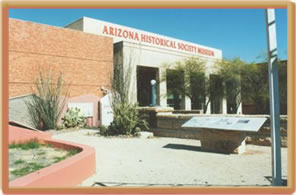
Tempe Division - Arizona Historical Society Museum
February 2005
We learned that the Arizona Historical Society has four divisions with in the state. The Pioneer Museum is located in Flagstaff and began in 1953 as the Northern Arizona Pioneers’ Historical Society. In 1985, the museum became a division of the state historical society. The Sanguinetti House Museum is located in Yuma Arizona. The history of the Yuma area revolves around the Colorado and Gila rivers, and the life that developed along their banks. For more than 1000 years men and women have hunted, farmed, and fished at the confluence of these rivers—some only passing through, others establishing roots and creating the Yuma we know today. Today the museum houses Rio Colorado Library and archives collection and is the home of the Adobe Annex museum shop. It carries turn-of-the-century-style gifts and the best selection of Yuma and Arizona history books in town. The Tucson Division located in Fort Lowell Park has museum buildings that are an accurate reconstruction of the commanding officer’s quarters. It houses exhibits on the history of the Apache Wars.
During our visit to Phoenix we toured the Tempe division. Tempe is located east of downtown Phoenix it is home to over 160,000 residents and Arizona State University - the fifth largest university in the United States. The museum is located at Papago Park and has exhibits related to the impact of water in the desert, the development of agriculture, transportation, and the home front during World War II. Researchers can use the library, archives, and materials. The archives contain a rich oral history and film collection, as well maps and architectural drawings. Artifact collections related to farming, World War II, and clothing depict the changing material culture of this area from the late-19th century to the present.
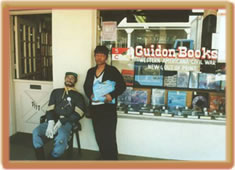
Carmon Weaver Hicks with our bag of books
BSRM February 2005
Next, we traveled north of downtown Phoenix to the community of Scottsdale. It has one of the largest shopping districts in the United States and specializes in traditional and contemporary original western art. Guidon Bookstore carries a large selection of titles on Western American and Civil War memorabilia and books. The owner is knowledgeable about the role the Buffalo Soldiers played in the American West. In this bookstore, there is a section dedicated to these soldiers with maps and other materials that you will not find in other bookstores. It is located at 7117 Main Street in Old Town. Visit there website - http://www.guidon.com.
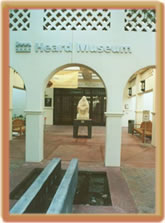
For our next research adventure, we headed to the Heard Museum. It was founded in 1929 by Dwight B. and Marie Bartlett Heard to house their personal collection of American Indian artifacts and art. This private, non-profit museum has earned a national and international reputation for its thorough and sensitive representation of American Indian cultures and heritage, especially those in the Southwest.

The Heard Museum is located near downtown Phoenix at 2301 North Central Avenue (602-252-8840). Website www.heard.org.
.
Driving east thirty minutes from downtown Phoenix, we arrived at Apache Junction
to visit some old friends. We were in the middle of heavy traffic due to
the western expansion that lives on today. Eventually we noticed lots of
greenery. We enjoyed a steak dinner and good conversation with Joan and
Tom. Joan agreed to read and edit our manuscript –Our Journey with
the Buffalo Soldiers. We have a way of blending our research with fun…
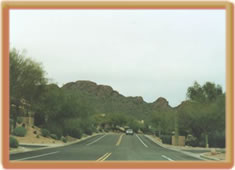
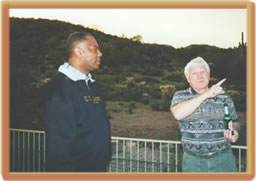
Route 60 East to Apache Junction (left)
George Hicks, III and Tom Hellum (right)
February 2005
Reflections
Our travels in Phoenix and the surrounding areas gave us a better understanding
of the American Indian culture. They had an influence on the African American
cavalry soldiers and the soldiers had a mutual influence on their culture.
The U.S. government declared war on the American Indians (Indians Wars 1866-1890),
but the Buffalo Soldiers understood their position. They had just won their
freedom a few years earlier and needed to prove their worth. These two groups
shared many similarities. As we research the Buffalo Soldiers’ stories,
our efforts have concentrated on the “common soldier.” We are
able to relate the common soldier’s story to the American Indian and
the westward expansion. They are an important component that formed the foundation
of the military.
